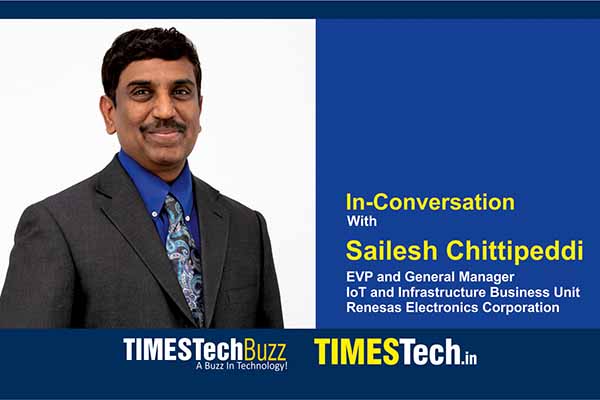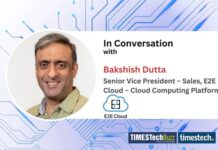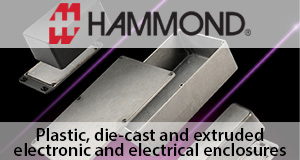Nowadays, technological improvements in consumer electronics are focused on making life easier by incorporating IoT into devices. Microprocessors are required for data processing and transfer in such devices. Companies in the core electronics sector are substantially spending in research and development to improve the capabilities and performance of their chips and circuits. Renesas is one of the world’s largest semiconductor manufacturers. It has been heavily investing in R&D and recently announced a partnership with Tata Sons as well as acquisition of Reality AI. We interviewed with Mr. Sailesh Chittipeddi, Renesas’ Executive Vice President and General Manager, IoT and Infrastructure Business Unit, to learn more about the company’s recent acquisitions and India as a growing manufacturing hub.
TimesTech: We want to start with the biggest news of the day. Renesas has recently announced a strategic partnership with Tata Motors. My question is how do you see India as a growing manufacturing hub and what key plans do you have for your Indian subsidiary?
Sailesh Chittipeddi: Yes, the partnership that we announced is not just with Tata Motors, it was with Tata sons. So, it covers the partnership with Tata Motors as well as with Tejas Networks, Sannkhya Labs and our Joint Innovation Center that we’re setting up with TCS in Bengaluru. And you know from our perspective, India is at an inflection point. They’re very serious about growing the electronics ecosystem in India. The consumption of electronics in India is going to increase greatly and we see that happening and certainly, one element of it is automotive. But also, I think the other part is the networking opportunities, the opportunities for industrial as well as IoT will grow significantly over time, especially with the present government’s initiatives to build more components within India, so from our perspective, we really see Tata as being a great anchor partner, not only from a development perspective but also from a strategic perspective for us as the India market expands we will be able to grow our content and help the overall ecosystem.
So, for us, the partnership with Tata is just the foundation. It doesn’t mean they are sole customers, that certainly not the intent but they are a big customer and one what I would consider to be one of the anchor customers for us in the marketplace. But the idea then is, as India is reaching its inflection point in terms of local content for electronics manufacturing and historically, our presence in India hasn’t been as big as some of our competitors so certainly working with Tata allows us the name brand and the name recognition to expand our footprint. And I certainly think we accomplished that.
He later adds:
We already use SPEL in Chennai for some of our assembly efforts and we will continue to explore additional sources to meet our global manufacturing needs. As additional manufacturing sources become available in India, we will assess their capabilities to align with our needs. Our Indian subsidiary is not independent of Global Renesas so actions taken will align with the rest of our corporate needs.
TimesTech: So, my next question is, what are the key strategies of Renesas to drive further growth in industrial, IoT, etc and the mega trends that are shaping these sectors these days?
Sailesh Chittipeddi: Yeah. So, the big trend that we see, I mean automotive is the electrification trend that is you know the global trend and certainly will be true in India. But the other side of it on the IoT, it’s all about the intelligence, moving from the cloud to the endpoint. So today much more information is being processed closer to the endpoint and your smartphones are able to do much more than, say, smartphones even a decade ago. So, what it is much more processing and capability is moving towards the end point of the network or to the edge of the network and that will drive a lot of growth overall within markets. And the other major trend also is artificial intelligence, especially going to gain much more traction at the endpoint of the network. So, I think those are the big trends and industry, it’s really about sustainability and which means more energy efficiency within factories as well as better communications within the factory environment.
So, for us, it’s certainly driving more products and more initiatives in the area. One of the things that we are doing is driving more growth through new product innovation in that area. And when it comes to some of the markets, it is really finding out what is the leg up that we can give to our customers.
When it comes to these product definitions so that we can position ourselves better in the marketplace. So, for example, we acquired reality AI recently, which is a company based out of Maryland and it gives us a leg up in terms of servicing our industrial customers because they’re very much focused on the industrial market.
TimesTech: You mentioned data processing at the endpoint and you also talked about acquiring Reality AI. So, I wanted to know how signal processing at the endpoint is different from signal processing at the cloud and how it improves any device performance?
Sailesh Chittipeddi: Yeah, so largely you’ll find the cloud is still going to be the optimal point for doing something that is massively computed intensive. For example, things like weather forecasting, right? It would be very hard to do. Maybe some, you know, 100 years from now, you might be able to do it, but weather forecasting or looking at actuarial sciences or processing massive amounts of information that will always be the domain of the cloud. Not forever, but I mean in the reasonable time horizons, that’ll remain there. But other workloads can move towards the endpoint as the computing capability improves. For example, voice processing is a great example of something that you can do today locally, but if it’s native language processing, it’s still handling the cloud because of the complexity of what’s involved. But if you were to say, for example, wake up to your TV and it went to the cloud and came back, you’d be waiting a long time, right? You wouldn’t be too patient in dealing with something like that. So, you would be in a situation where you want things instantaneously. So, what’s driving the movement to the edge? These are actually a few factors. Number one is the desire for low latency , which means very quick feedback. The need the requirement for minimal bandwidth. So, if you have a sensor fusion network that is local, you want the information to be processed locally. You don’t want to go into the cloud and coming back as to how to manage the sensor network and privacy is associated with it is an important factor because sometimes when it comes to things like healthcare and stuff, you don’t want stuff going over the cloud where somebody can hack into it. Your personal healthcare information and safeguarding it. So those are kind of the major trends that are driving that.
TimesTech: OK, so moving further, there is also one big thing happening with Renesas, Renesas has invested $10 million in Arduino. So, Sir, I wanted to know how this collaboration will help Arduino to expand its product offering and what are the new technology integration we can see in Arduino hardware?
Sailesh Chittipeddi: Yeah, so Arduino has its massive base of broad-based users. It has over 30 million users globally in terms of their systems, so they certainly have their road map that is expanding more into the enterprise space. So, for us, it’s a question of saying, OK, how do we tap into this large base of users that they have because these users that are doing do-it-yourself kits or building the next generation of robotics kits, IoT kits, next generation of things that can have a very big impact. So, for us, it’s more being the ability to have a view of where Arduino is going and then integrate a tool flows and tool chains to take advantage of it. So, our customers then can very easily take one of these kits that one of the developers there has used and implemented in their system. So, think about it more along those lines of tapping into their user base and for us being able to provide that access to our customers fairly easily by using their tools and vice versa as well.
TimesTech: So now a trend has started off integrating IoT in every device and the toothbrush is the latest example. So how do you find penetration of IoT in every aspect of living healthy? What are your views on it?
Sailesh Chittipeddi: You know, look, that’s an interesting question. It depends really on the application. For example, there is an overreach possible always where like it happened in one, I won’t name them TV manufacturers, or when you’re talking to one of your home devices. Some of these things are always on and people don’t realize that. And you know, you could be screaming at your kid who’s having a fit or tantrum and somebody on the other side could be listening to it and come to the wrong conclusion, right. That there’s something going on when in reality there could be nothing that’s going on. So, the lack of privacy and the always-on state and some of these devices is obviously a concern. But on the other hand, there are things that you want to do locally where you want to have your health records, for example, you wanted to stay on your device. You don’t want to share it with somebody that should have no business or access to it. As to how much you’re exercising in a given day, or how many steps are you walking in a given day. So, you want that to be private. So, it’s gonna be a little bit of a tradeoff. OK, so to me there’s gonna be cases where you don’t want the guys interfering and what’s going on and there are cases where you want it to be essentially private and don’t want to provide that access to anybody else to tap and into your private networks. So, it’ll be a delicate line.
But I think the trend is here to stay. And I think increasingly with sensors measuring just about everything that you have, the intelligence will slowly but surely move much more towards the edge and the endpoint and it’ll be beneficial if used well. As with all things, it’s you know you could use something for good or you could use something for bad. But in general, if you tend to use it for good, I think it could have a lot of positive implications for the technology.
TimesTech: How does Renesas differentiate its sensor technology as a wide range of designs and uniquely architected solutions are getting critically important these days?
Sailesh Chittipeddi: So, for us, To Make Our Lives Easier, that’s the Renesas mission. By complementing human technology by complementing human capabilities. That’s how we do it. It’s a very simple tagline, but it has a lot of meaning relative to how we think about our business. It’s about the user experience and the customer experience. Whether it’s sensors, whether it’s microcontrollers, or any of our products. Are they easy to use and do they provide the value to get on safe? They needed to get on with the data set to the cloud. Can we do it faster than everybody else and be able to provide access to that information so very simple it is. The ease of use of our products and technologies will differentiate us in the marketplace and you know we are making good progress. We aren’t there yet because it’s a journey, it’s not a destination, but I think over time we will get significantly better and some of these things that we’re doing, like the Reality AI acquisition allows that because now the customers can figure out when their tool is going to break down by using our MCU and looking at some anomalous characteristics and be able to figure it out.
TimesTech: So, Sir, you mentioned sustainability and so progress in science until recently has ignored the environment and extraction of real earth metals for manufacturing of semiconductors is a very polluting activity. So, how Renesas is striving toward sustainable development?
Sailesh Chittipeddi: Yeah. So, from the manufacturing side, there’s a couple of things that we are doing and our factories are certainly. Working on the recycling of water recycling of precious of some of the materials that we use within the factories as well as in terms of reducing our carbon footprint overall, we’ve set a target to be carbon neutral by 2050 and we’re pushing towards it as a company. Overall, in terms of what we need to do and we have sustainability initiative set up across the company for driving improvement in each of the activities, whether it’s the products that we introduce by using lower power consumption and focusing on power efficiency, that is an important factor. If you think about it, whether it’s the infrastructure where you know, you almost need a nuclear power plant to power a few data centers right to IoT devices where we’re moving to battery-free technologies. Those are some of the things that we are working on from a sustainability and green and a shifting perspective.
TimesTech: Government of India has recently announced a semiconductor mission of Rs 75000 crore ($10 billion) for the development of sustainable semiconductors and display ecosystems in the country. Does Renesas have any plan to work with the Government of India?
Sailesh Chittipeddi: We are aware of the 10 B$ investment incentives, we are not participating in the PLI scheme at this time. However, we are committed to helping develop a sustainable semiconductor ecosystem in India together with our partners and are taking actions consistent with that goal














